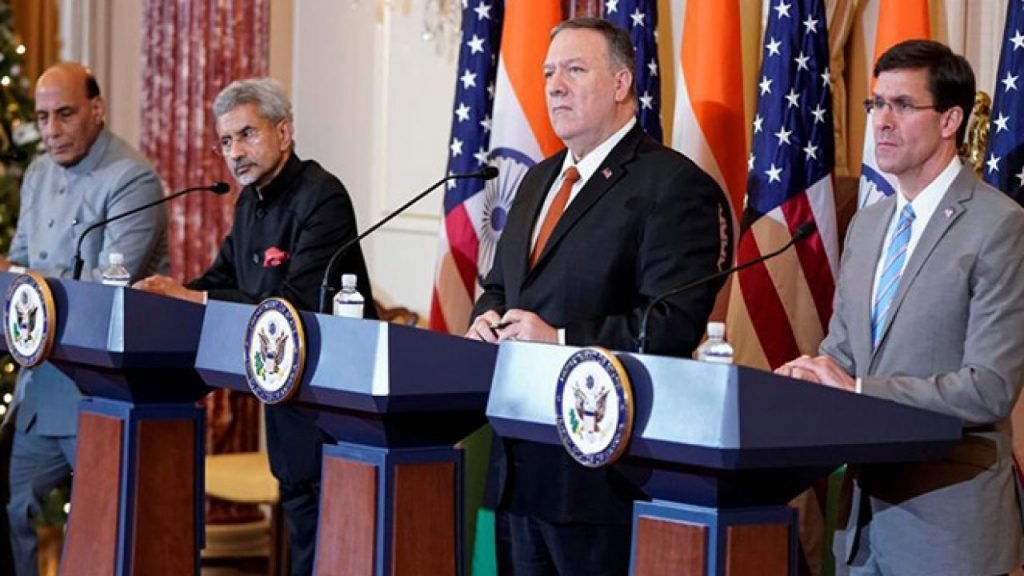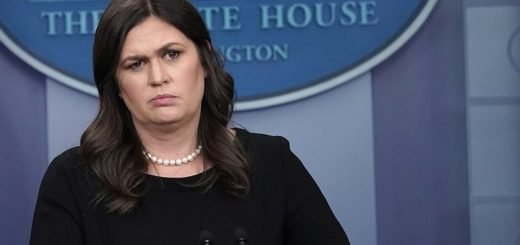US – India 2-Plus-2 Dialogue – Improvising on QUAD

Ever since the US voiced its concerns against Chinese expansionist designs on the global stage, especially in the context of the BRI initiative, several simultaneous efforts have been taken to contain China’s rise. Besides the QUAD, the US-India Two Plus Two Dialogue (2+2) is one such effort that was initiated in 2016. The new framework of the ministerial dialogue was initiated in order to provide a forward-looking vision for the strategic partnership between the two countries. Significant achievements were made by the late External Affairs Minister Sushma Swaraj and Nirmala Sitharaman along with their counterparts – secretary of state Rex Tillerson and defence secretary James Mattis in April 2018 and the mechanism has eventually evolved. Dialogue partners also involved Japan and Australia; while Japan has been extensively using this mechanism for several years India has become more prone to use it over the last few years.

Notably, while the QUAD initiative is more enhanced due to its long inception time and Japan’s specific interest in it, the US-India 2-plus-2 holds more water given the specific defence engagement of the involved countries. By October 2020, when the third dialogue was held, both US and India substantively generated a platform that dealt with various aspects besides trade and connectivity including the Logistics Exchange Memorandum of Agreement (LEMOA) and the Communications Compatibility and Security Agreement (COMCASA) and the General Security of Military Information Agreement (GSOMIA) and the Basic Exchange and Cooperation Agreement (BECA). These foundational agreements laid the ground for the exchange of crucial military information. With Trump not being re-elected some of these initiatives will find themselves at the crux of the change sought by the new administrations.
However, the talks have advanced with both sides discussing Chinese aggression and the concomitant defence requirements whereby India has acquired high-end armed drones like MQ-9B, which uses spatial data for pinpointed strikes. Issues of critical importance that remain at the nub of discussions are Pakistan-sponsored terrorism and the Afghan peace process. Though the US has voiced concerns regarding India’s oil imports from Iraq, this dialogue is a good opportunity to avoid Russia’s sanctions on Indian weaponry and has more to offer to India than any other defence architecture. Towards this endeavour, India has decided to post a liaison officer in the Bahrain-based US Naval Forces Central Command and likewise, a US officer will be posted at the International Fusion Centre for Indian Ocean Region in India. These cross-postings will enhance maritime security cooperation, increase maritime domain awareness and help in fine-tuning humanitarian assistance and disaster relief activities.

Approach of the New US Administration
Obligations towards this dialogue have been endorsed by President-elect Joseph Biden who spoke of the “Asia-Pacific” and appeared to jettison the concept of “Indo-Pacific.” The secretary of Defence, Gen. Lloyd Austin also emphasized the importance of maintaining alliances, while the leaders of Japan and South Korea suggested a change in the approach from “free and prosperous Indo-Pacific” to “a secure and prosperous Indo-Pacific.” With China’s designs on the Indian Ocean, the US’ growing interest is perceptible in the Indo-Pacific region. Moreover, it provides a regional fillip to the Indo-US security dialogue. The new administration also aims to strengthen this dialogue which is a major achievement of the security cooperation process which began 15 years ago. The scope has expanded to important issues like energy cooperation, connectivity, people to people contacts, science and technology cooperation.
However, an interesting part of the dialogue has been the mutual exchange of manufactured items in the defence realm. Recently, Defence Minister Raj Nath Singh highlighted the importance of US investment in India’sMake in India’ program and the fact that US investment can help India become self-reliant in defence manufacturing through purchase and renewal, thereby allowing Indian industries to have a more level playing field in the US market. Though the dialogue has been postponed under the new administration, it cannot be ruled out that the US’ interest in India’s role in the Indo-Pacific is providing India with the chance it much needed to take back its traditional role in the down South.

Future Prospects
The 2 +2 dialogue is a strong response to the overtures by Russia and China through military exercises like the Vostok 2018. These geopolitical necessities have forced the US to realize that it needs strong allies and players in the Pacific region or else it would soon lose its hegemonic influence. As a counter-strategy, the US has begun investing more in India’s defence procurements and technology and unlike the QUAD which is restricted to Japan, Australia along with these two strong players, the Two-plus-two mechanism has a wider scope to involve other countries with similar interests. Hence it provides stronger bonding through official channels beyond the objectives of the QUAD.
Though the QUAD held its third formal meeting on 18 February 2021 under the guidance of Dr S. Jaishankar, where India officially acknowledged its interest and commitment to the mechanism, the QUAD still remains a consultative mechanism[1] and a not binding defence partnership and the discussions are largely restricted to climate change, maritime security, counter-terrorism etc. Highlighting their shared attributes as political democracies, market economies and pluralistic societies, the US, India, Japan and Australia recognized that the changes underway in the world make a strong case for their countries working closely together.
Meanwhile, China’s increasing footprints in the Indian Ocean region are a major cause of concern to India. The US acknowledges that Indian security interest in this region needs to be safeguarded which will emerge as a new security frontier challenge between these two Asian giants. Thus the two-plus-two mechanism provides for a secure channel of maximum transparent communication between the defence and external affairs minister of the countries involved so as to enable them to maximize their security interests and hence the mechanism will prove to be of immense significance as the cooperation enhances in the years to come. Moreover, the scope remains open for other countries like the ASEAN to join which will give shape to a broader mechanism beyond QUAD.
[1] Noting that regular Quad consultations hold value, the Ministers agreed to continue these useful discussions.


















